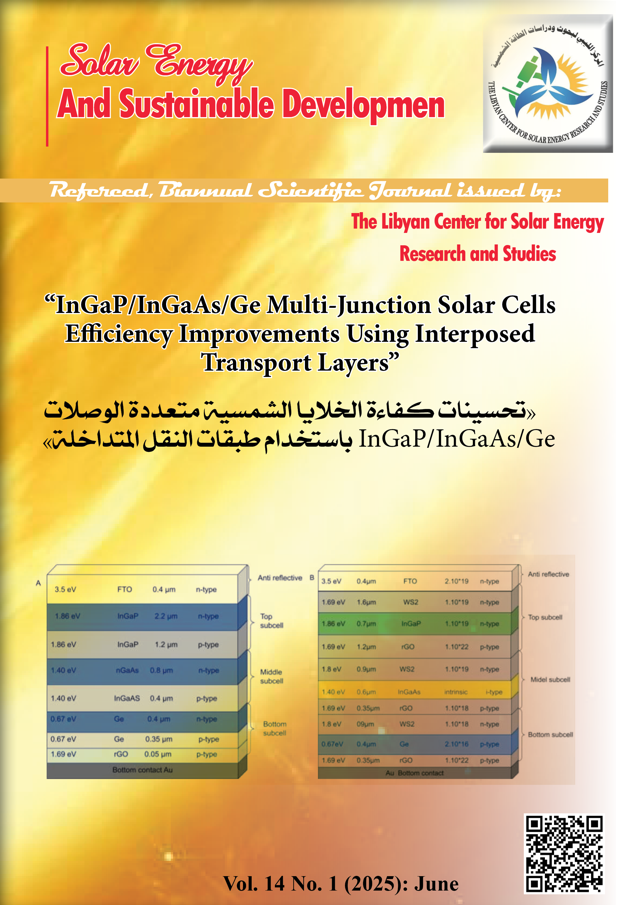InGaP/InGaAs/Ge multi-junction solar cells efficiency improvements using interposed transport layers
DOI:
https://doi.org/10.51646/jsesd.v14i1.338Keywords:
III-V semiconductor, multi-junction solar cell, ETL WS2, HTL rGO, SCAPS 1DAbstract
The high conversion efficiency of solar cells can make them more competitive in cost compared to conventional energy sources. Therefore, enhancing photovoltaic cell efficiency remains a critical challenge for researchers and manufacturers. Shockley-Queisser single junction photovoltaic cells are limited to 33.7%, and multi-junction solar cells are the most promising technologies that have achieved remarkable efficiencies exceeding 46%. Modeling and simulation are essential to optimize semiconductor devices and reduce their development time and cost. This study investigates the performance improvement of novel InGaP/InGaAs/Ge triple-junction solar cells by integrating III-V semiconductors. The design includes Tungsten disulfide as an electron transport layer, reduced graphene oxide as a hole transport layer, and intrinsic InGaAs layers to improve efficiency in decreasing the number of InGaP, InGaAs, and Ge layers to reduce manufacturing costs. SCAPS 1D software was used to simulate under a solar irradiance of 1000 Wm-2 and an air mass of AM1.5G spectrum at 25°C. In addition, a commercial InGaP/InGaAs/Ge solar cell and a mini-solar panel were also simulated, and the obtained current-voltage characteristics were compared with experimental data. A strong correlation was observed between the simulated data and the experimental measurements, confirming the proposed solar cell design's potential, accuracy, and reliability. The new structure produced an impressive power conversion efficiency of 49.83%. The findings suggest a route to manufacturing new multi-junction photovoltaic cells with high efficiency and lower cost.
Downloads
Metrics
References
Q. Hassan, P. Viktor, T.J. Al-Musawi, B.M. Ali, S. Algburi, H.M. Alzoubi, A.K. Al-Jiboory, A.Z. Sameen, H.M. Salman, and M. Jaszczur, “Renewable energy role in the global energy Transformations”, Renewable Energy Focus, Vol. 48, pp. 100545, 2024. DOI: https://doi.org/10.1016/j.ref.2024.100545
J. Wang, and W. Azam, “Natural resource scarcity, fossil fuel energy consumption, and total greenhouse gas emissions in top emitting countries”, Geoscience Frontiers, Vol. 15, no. 2, pp. 101757, 2024. DOI: https://doi.org/10.1016/j.gsf.2023.101757
B.J. van Ruijven, E. De Cian, and I. Sue Wing, “Amplification of future energy demand growth due to climate change”, Nature Communications, Vol. 10, no. 1, pp. 2762, 2019. DOI: https://doi.org/10.1038/s41467-019-10399-3
A. Machín, and F. Márquez, “Advancements in photovoltaic cell materials: Silicon, Organic, and Perovskite Solar cells”, Materials, Vol. 17, no. 5, pp. 1165, 2024. DOI: https://doi.org/10.3390/ma17051165
F. Mneimneh, H. Ghazzawi, M. Hejjeh, M. Manganelli, S. Ramakrishna, “Roadmap to Achieving Sustainable Development via Green Hydrogen”, Energies, vol. 16, no. 3, p. 1368, 2023. DOI: https://doi.org/10.3390/en16031368
U.S. Energy Information Administration - EIA, “Carbon dioxide Emissions Coefficient”, 2022. Available at: https://www.eia.gov/environment/emissions/co2_vol_mass.php (Accessed: 11 December 2023)
S. Plastras, D. Tsoumatidis, N.D. Skoutas, A. Rouskas, G. Kormentzas, and C. Skianis, “Non-Terrestrial Networks for Energy-Efficient Connectivity of Remote IoT Devices in the 6G Era: A Survey”, Sensors, Vol. 24, no. 4, pp. 1227, 2024. DOI: https://doi.org/10.3390/s24041227
R. Sharma, S. Chuhadiya, M.S. Dhaka, and K. Himanshu, “CdZnTe thin films as proficient absorber layer candidates in solar cell devices: a review”, Energy Advances, Vol. 2, pp. 1980-2005, 2023. DOI: https://doi.org/10.1039/D3YA00120B
N. Wang, F. Meng, L. Zhang, and Z. Liu. “Light soaking of hydrogenated amorphous silicon: a short review”, Carbon Neutrality, Vol. 3, no. 1, pp. 18, 2024. DOI: https://doi.org/10.1007/s43979-024-00093-9
J. Pastuszak, P. Wegierek, “Photovoltaic cell generations and current research directions for their development”, Materials, Vol. 15, no. 16, pp. 5542, 2022. DOI: https://doi.org/10.3390/ma15165542
S. Ullah, A. Gulnaz, and G.W. Wang, “Modeling and Simulation of Heterojunction Solar Cell with Mono Crystalline Silicon”, Journal of Applied Mathematics and Physics, Vol. 12, no. 3, pp. 997-1020, 2024. DOI: https://doi.org/10.4236/jamp.2024.123061
A.D. Dhass, D. Patel, and B. Patel, “Estimation of power losses in single-junction gallium-arsenide solar photovoltaic cells”, International Journal of Thermofluids, Vol. 17, pp. 100303, 2023. DOI: https://doi.org/10.1016/j.ijft.2023.100303
A.Y. Alsalloum, B. Turedi, K. Almasabi, X. Zheng, R. Naphade, S.D. Stranks, O.F. Mohammed, and O.M. Bakr, “22.8%-Efficient single-crystal mixed-cation inverted perovskite solar cells with a near-optimal bandgap”, Energy & Environmental Science, Vol. 14, no. 4, pp. 2263-2268, 2021. DOI: https://doi.org/10.1039/D0EE03839C
S.M. Uddin, M.I.A. Bakar, and M.H.H. Mohd Rozlan, “Investigation of Multi-Junction GaInP/GaInAs/Ge Solar Cells Performance Characteristics using MATLAB Simulation”, Paper presented at ICE2T 2023 – 4th edition. Proceedings of the 2023 International Conference on Engineering Technology and Technopreneurship (ICE2T), Vol. 15, no. 16, pp. 360-365, August, 2023. DOI: https://doi.org/10.1109/ICE2T58637.2023.10540472
M.B. de la Mora, O. Amelines-Sarria, B.M. Monroy, C.D. Hernández-Pérez, and J.E. Lugo, “Materials for downconversion in solar cells: Perspectives and challenges”, Solar Energy Materials and Solar Cells, vol 165, pp. 59-71, 2017. DOI: https://doi.org/10.1016/j.solmat.2017.02.016
P. Subudhi, and D. Punetha, “Pivotal avenue for hybrid electron transport layer-based perovskite solar cells with improved efficiency”, Scientific Reports, Vol. 13, no. 1, pp. 19485, 2023. DOI: https://doi.org/10.1038/s41598-023-33419-1
R.M. France, J. Geisz, T. Song, W. Olavarria, M. Young, A. Kibbler, and M.A. Steiner, “Triple-junction solar cells with 39.5% terrestrial and 34.2% space efficiency enabled by thick quantum well superlattices”, Joule, Vol. 6, no. 5, pp. 1121-1135, 2022. DOI: https://doi.org/10.1016/j.joule.2022.04.024
D. Kumar, N. Kumar, and L. Kumar, “Impact of operating temperature and solar concentration on the conversion efficiency of InGaP/InGaAs/Ge hybrid triple-junction solar cell”, Brazilian Journal of Physics, Vol. 53, no. 1, pp. 31 2023. DOI: https://doi.org/10.1007/s13538-022-01248-8
A. Baiju, and M. Yarema, “Status and challenges of multi-junction solar cell technology”, Frontiers in Energy Research, Vol. 10, pp. 971918, 2022. DOI: https://doi.org/10.3389/fenrg.2022.971918
A.A. Abushattal, A.G. Loureiro, and N.E.I. Boukortt, “Ultra-High Concentration Vertical Homo-Multijunction Solar Cells for CubeSats and Terrestrial Applications”, Micromachines, Vol. 15, no. 2, pp. 204, 2024. DOI: https://doi.org/10.3390/mi15020204
P. Schygulla, R. Müller, O. Höhn, M. Schachtner, D. Chojniak, A. Cordaro, S. Tabernig, B. Bläsi, A. Polman, G. Siefer, D. Lackner, and F. Dimroth, “Wafer-bonded two-terminal III-V//Si triple-junction solar cell with power conversion efficiency of 36.1 % at AM1.5G”, Progress in Photovoltaics: Research and Applications, Vol; 33, no. 1, pp.100-108, 2025. DOI: https://doi.org/10.1002/pip.3769
M.A. Green, E.D. Dunlop, M. Yoshita, N. Kopidakis, K. Bothe, G. Siefer, D. Hinken, M. Rauer, J. Hohl-Ebinger, X. Hao, et al. “Solar cell efficiency tables (Version 64)”, Progress in Photovoltaics: Research and Applications, Vol. 32, no. 7, pp. 425-441, 2024.
D.O. Nielsen, C.G. Van de Walle, S.T. Pantelides, R.D. Schrimpf, D.M. D.M. Fleetwood, and M.V. Fischetti, “First-principles approach to closing the 10–100 eV gap for charge-carrier thermalization in semiconductors”, Physical Review B, Vol. 108, no 15, p. 155203, 2023. DOI: https://doi.org/10.1103/PhysRevB.108.155203
B. Amiri, and A. Belghachi, “First-principles investigation of absorption coefficient in quantum well designed for solar cells”, Optik, Vol. 202, pp. 163554, 2020. DOI: https://doi.org/10.1016/j.ijleo.2019.163554
A. Sahu, K. Hiremath, and A. Dixit, “Limiting efficiency factors and their consequences on quantum dot sensitized solar cells: a detailed balance study”, Applied Physics A, Vol. 124, pp. 1-8, 2018.
A.S. Brown, and M.A. Green, “Detailed balance limit for the series-constrained two-terminal tandem solar cell”, Physica E: Low-dimensional Systems and Nanostructures, Vol. 14, no. 1-2, pp. 96-100, 2002. DOI: https://doi.org/10.1016/S1386-9477(02)00364-8
S. Abdul Hadi, E.A. Fitzgerald, and A. Nayfeh, “Theoretical efficiency limit for a two-terminal multi-junction “step-cell” using detailed balance method”, Journal of Applied Physics, Vol. 119, no. 7, pp. 073104, 2016. DOI: https://doi.org/10.1063/1.4942223
K. NNguyen-Vinh, S. Gonapaladeniya, N. Nguyen-Quang, and Z. Leonowicz,“A Review of Photovoltaic Technology”, In : 2024 24th International Scientific Conference on Electric Power Engineering (EPE). IEEE, p. 1-6, 2024. DOI: https://doi.org/10.1109/EPE61521.2024.10559575
J.F. Geisz, R.M. France, K.L. Schulte, M.A. Steiner, A.G. Norman, H.L. Guthrey, M.R. Young, T. Song, and T. Moriarty, “Six-junction III–V solar cells with 47.1% conversion efficiency under 143 Suns concentration”, Energy, Vol. 5, no. 4, pp. 326-335, 2020.
P. Schygulla, R. Müller, D. Lackner, O. Höhn, H. Hauser, B. Bläsi, F. Predan, J. Benick, M. Hermle, S.W. Glunz, and F. Dimroth, “Two‐terminal III–V//Si triple‐junction solar cell with a power conversion efficiency of 35.9% at AM1. 5g” Progress in Photovoltaics: Research and Applications, Vol. 30, no. 8, pp. 869-879, 2022. DOI: https://doi.org/10.1002/pip.3503
S. Essig, C. Allebé, T. Remo, J.F. Geisz, M.A. Steiner, K. Horowitz, L. Barraud, J.S. Ward, M. Schnabel, A. Descoeudres, et al. “Raising the one-sun conversion efficiency of III–V/Si solar cells to 32.8% for two junctions and 35.9% for three junctions”, Nature Energy, Vol. 2, no. 9, pp. 1-9, 2017. DOI: https://doi.org/10.1038/nenergy.2017.144
A. Aho, R. Isoaho, M. Raappana, T. Aho, E. Anttola, J. Lyytikäinen, A. Hietalahti, V. Polojärvi, A. Tukiainen, J. Reuna, et al. “Wide spectral coverage (0.7–2.2 eV) lattice‐matched multijunction solar cells based on AlGaInP, AlGaAs, and GaInNAsSb materials”, Progress in Photovoltaics: Research and Applications, Vol. 29, no. 7, pp. 869-875, 2021. DOI: https://doi.org/10.1002/pip.3412
V.K. Sharma, E.A. Kumar, and S.S. Murthy, “Influence of dynamic operating conditions on the performance of metal hydride-based solid sorption cooling systems”, International Journal of Hydrogen Energy, Vol. 40, no. 2, pp. 1108-1115, 2015. DOI: https://doi.org/10.1016/j.ijhydene.2014.11.084
V. Thakur, B.M. Yu Jeco-Espaldon, and Y.Okada, “Luminescent coupling effect in InGaP/GaAs/InGaAs inverted metamorphic triple-junction solar cell”, Journal of Photonics for Energy, Vol. 14, no. 1, pp. 015503-015503, 2024. DOI: https://doi.org/10.1117/1.JPE.14.015503
M. Yamaguchi, F. Dimroth, J.F. Geisz, N.J. Ekins-Daukes, “Multi-junction solar cells paving the way for super-high efficiency”, Journal of Applied Physics, Vol. 129, no. 24, pp. 240901, 2021. DOI: https://doi.org/10.1063/5.0048653
L. Boucerredj, “Modélisation et simulation d’un système photovoltaïque par la commande MPPT”, Algerian Journal of Engineering Architecture and Urbanism, Vol. 5, no. 5, pp. 197-205, 2021.
K.G. Beepat, D.P. Sharma, A. Mahajan, D. Pathak, V. Kumar, “Simulation of multijunction solar cell interfaces for enhancement of the power conversion efficiency”, Discover Applied Sciences, Vol. 6, no. 6, pp. 1-19, 2024. DOI: https://doi.org/10.1007/s42452-024-05930-1
X. Zhang, S. Huang, J. Liu, K. Lin, Y. Wang, and W. Yang, Research on monolithic AlGaInP/AlGaInAs/GaInAs/Ge quadruple-junction solar cell for high efficiency lattice-matched tandem photovoltaic device. Applied Physics Express, vol. 13, no 7, pp. 071002, 2020. DOI: https://doi.org/10.35848/1882-0786/ab9990
D. Sharma, R. Mehra, and B. Raj, “Methods for Integration of III-V Compound and Silicon Multijunction for High Efficiency Solar Cell Design”, Silicon, Vol. 14, no. 15, pp. 9797-9804, 2022. DOI: https://doi.org/10.1007/s12633-022-01691-x
O.A. Al-Shahri, F.B. Ismail, M.A. Hannan, M.S. Hossain Lipu, A.Q. Al-Shetwi, R.A. Begum, N.F.O. Al-Muhsen, and E. Soujeri, “Solar photovoltaic energy optimization methods, challenges and issues: A comprehensive review”, Journal of Cleaner Production, Vol. 284, pp. 125465, 2021. DOI: https://doi.org/10.1016/j.jclepro.2020.125465
K. Dasgupta, A. Mondal, S. Ray, U. Gangopadhyay, “Mathematical modeling of a novel heterojunction SIS front surface and interdigitated back-contact solar cell”, Journal of Computational Electronics, Vol. 20, 5, pp. 1779-1806, 2021. DOI: https://doi.org/10.1007/s10825-021-01735-2
O. Richard, A. Turala, V. Aimez, M. Darnon, and A. Jaouad, “Low-Cost Passivated Al Front Contacts for III-V/Ge Multijunction Solar Cells”, Energies, Vol. 16, no. 17, pp. 6209, 2023. DOI: https://doi.org/10.3390/en16176209
M.H. Tsutagawa, and S. Michael, “Sherif. Triple junction InGaP/GaAS/Ge solar cell optimization: the design parameters for a 36.2% efficient space cell using Silvaco ATLAS modeling & simulation”. In : 2009 34th IEEE Photovoltaic Specialists Conference (PVSC). IEEE, p. 001954-001957, 2009. DOI: https://doi.org/10.1109/PVSC.2009.5411544
A.K. Hamid, N.T. Mbungu, A. Elnady, R.C. Bansal, A.A. Ismail, and M.A. AlShabi, “A systematic review of grid-connected photovoltaic and photovoltaic/thermal systems: Benefits, challenges and mitigation”, Energy & Environment, Vol. 34, no. 7, pp. 2775-2814, 2023. DOI: https://doi.org/10.1177/0958305X221117617
K. Araki, Y. Ota, H. Saiki, H. Tawa, K. Nishioka, and M. Yamaguchi, “Super-multi-junction solar cells—device configuration with the potential for more than 50% annual energy conversion efficiency (non-concentration)”, Applied Sciences, Vol. 9, no. 21, pp. 4598, 2019. DOI: https://doi.org/10.3390/app9214598
M. Burgelman, K. Decock, S. Khelifi, A. Abass, “Advanced electrical simulation of thin film solar cells”, Thin Solid Films, Vol. 535, pp. 296–30, 2013. DOI: https://doi.org/10.1016/j.tsf.2012.10.032
P. Calado, I. Gelmetti, B. Hilton, M. Azzouzi, J. Nelson, and P.R.F. Barnes, “Diffusion: an open-source code for simulating ordered semiconductor devices with mixed ionic-electronic conducting materials in one dimension”, Journal of Computational Electronics, Vol. 21, pp. 960–991, 2022. DOI: https://doi.org/10.1007/s10825-021-01827-z
S. Karthick, S.Velumani, and Bouclé, Experimental and SCAPS simulated formamidinium perovskite solar cells: A comparison of device performance. Solar Energy, vol. 205, pp. 349-357, 2020. DOI: https://doi.org/10.1016/j.solener.2020.05.041
E.H. Houssein, G.N. Zaki, A.A.Z. Diab, and E.M. Younis, “An efficient Manta-Ray Foraging Optimization algorithm for parameter extraction of a three-diode photovoltaic model”, Computers & Electrical Engineering, Vol. 94, pp. 107304, 2021. DOI: https://doi.org/10.1016/j.compeleceng.2021.107304
A. Zhao, Y. Wang, and L. Chen, "MRFO: A novel metaheuristic algorithm for global optimization," IEEE Access, vol. 8, pp. 12345–12358, 2020.
H. Zhang, X. Li, and P. Kumar, "Application of MRFO in energy-efficient system design," IEEE Transactions on Industrial Electronics, vol. 68, no. 7, pp. 5678–5689, 2021.
D.T. Cotfas, M. Madhiarasan, P.A. Cotfas, “Extraction of the multijunction solar cell parameters using two metaheuristic algorithms”, IEEE Access, Vol. 12, pp. 109634-109656, 2024. DOI: https://doi.org/10.1109/ACCESS.2024.3439344
P.A. Cotfas, D.T. Cotfas, “Design and implementation of RELab system to study solar and wind energy”, Measurement, Vol. 93, no. 94-101, 2016. DOI: https://doi.org/10.1016/j.measurement.2016.06.060
F.F. Muhammadsharif, “A new simplified method for efficient extraction of solar cells and modules parameters from datasheet information”, Silicon, Vol. 14, no. 6, pp. 3059-3067, 2022. DOI: https://doi.org/10.1007/s12633-021-01097-1
Thin Triple-Junction Solar Cell for Space Applications, 2020, [online] Available:
https://www.cesi.it/app/uploads/2020/03/Datasheet-CTJ30-Thin.pdf
T. Bidaud, F. Ayari, P. Ferreol, C. Jouanneau, A. Turala, S. Moreau, M. Volatier, V. Aimez, S. Fafard, A. Jaouad, M. Darnon, and G. Hamon, “Multi-Terminal GaInP/GaInAs/Ge Solar Cells for Subcells Characterization”. Energies, vol. 17, no. 11, 2538, 2024. DOI: https://doi.org/10.3390/en17112538
S.S. Soley and A.D.D. Dwivedi, “Numerical simulation and performance analysis of InGaP, GaAs, Ge single junction and InGaP/GaAs/Ge triple junction solar cells”, Materials Today: Proceedings, Vol. 39, Part 5, pp. 2050-2055,2021 DOI: https://doi.org/10.1016/j.matpr.2020.11.056
Z. Ziani, M. Y. Mahdad, M. Z. Bessenouci, M.C. Sekkal, and N. Ghellai, “Enhancing Multi-Junction Solar Cell Performance: Advanced Predictive Modeling and Cutting-Edge CIGS Integration Techniques”, Energies, Vol. 17 no.18, p.4669, 2024. DOI: https://doi.org/10.3390/en17184669
W. Zhao, N. Yang, J. Li, L. Fang, W. Han, W. Lv, M. Yin, and J. Zhang, “Practical Verification and Comparative Analysis of One- and Two-Diode Models of Space Triple-Junction InGaP2/InGaAs/Ge Solar Cell”. Journal of Electronic Materials, Vol. 52, pp. 2580–2586, 2023. DOI: https://doi.org/10.1007/s11664-023-10220-4
A.G. Martin, D.D. Ewan, Y. Masahiro, K. Nikos, B. Karsten, S. Gerald, H. David, R. Michael, H. Jochen, and H. Xiaojing, “Solar cell efficiency tables (Version 64)”, Progress in Photovoltaics: Research and Applications, Vol. 32, no. 7, pp. 425-441, 2024. DOI: https://doi.org/10.1002/pip.3831
A. Sahu, K. Hiremath, and A. Dixit, “Limiting efficiency factors and their consequences on quantum dot sensitized solar cells: a detailed balance study” Applied Physics A, Vol. 124, pp. 1-8, 2018. DOI: https://doi.org/10.1007/s00339-018-1963-0
J. Liu, X. Wang, and Y. Chen, "Tungsten disulfide (WS₂) for stable and efficient perovskite solar cells," IEEE Transactions on Nanotechnology, vol. 21, pp. 233–240, 2023.
S. K. Sharma, P. K. Singh, and S. Islam, "Enhanced charge transport in perovskite solar cells using WS₂ as an electron transport layer," IEEE Journal of Photovoltaics, vol. 11, no. 3, pp. 456–462, 2022..
Y. Zhang, Y. Wang, S. Liu, and J. Wu, "Reduced graphene oxide (rGO) as an efficient charge transport material in solar cells," J. Mater. Chem. A, vol. 8, no. 24, pp. 12056-12073, 2020.
A. Smith, B. Johnson, and C. Lee, "Thermal stability of reduced graphene oxide in photovoltaic applications," Solar Energy Mater. Sol. Cells, vol. 95, no. 5, pp. 1321-1327, 2019.
N. Shrivastav, J. Madan, M.K. Hossain, M.D. Albaqami, and R. Pandey, “Design and simulation of three-junction all perovskite tandem solar cells: A path to enhanced photovoltaic performance”, Materials Letters, Vol. 362, no. 136169, 2024. DOI: https://doi.org/10.1016/j.matlet.2024.136169
M.A. Green, E.D. Dunlop, G. Siefer, M. Yoshita, N. Kopidakis, K. Bothe, X. Hao, “Solar cell efficiency tables (Version 61)”, Progress in Photovoltaics: Research and Applications, vol. 31, no 1, p. 3-16, 2023,. DOI: https://doi.org/10.1002/pip.3646
Shaker, L.M., Al-Amiery, A.A., Hanoon, W. K. Al-Azzawi, and A. A.H. Kadhum, “Examining the influence of thermal effects on solar cells: a comprehensive review”, Sustainable Energy Research, Vol. 11, p. 6, 2024. DOI: https://doi.org/10.1186/s40807-024-00100-8
F. Dhiabi, O. Benelmir, and A. Saadoune, “Studying the effects of temperature on InGaP/InGaAs/Ge triple junction solar cells using PyAMS Software”. Studies in Engineering and Exact Sciences, vol. 5, no 2, pp. e11388-e11388, 2024. DOI: https://doi.org/10.54021/seesv5n2-604
L.M.N. Nieto, J.P.F. Rodríguez, R.M, Campos, and P.J.P. Higueras. “Multi-junction solar cell measurements at ultra-high irradiances for different temperatures and spectra”, Solar Energy Materials and Solar Cells, Vol. 266, pp. 112651, 2024. DOI: https://doi.org/10.1016/j.solmat.2023.112651
J.F. Geisz, R.M. France, K.L. Schulte, M.A. Steiner, A.G. Norman, H. L.Guthrey, and T. Moriarty, “Six-junction III–V solar cells with 47.1% conversion efficiency under 143 Suns concentration”, Nature energy, Vol, 5 no. 4, pp. 326-335, 2020. DOI: https://doi.org/10.1038/s41560-020-0598-5
A.W. Bett, F. Dimroth, W. Guter, R. Hoheisel, E. Oliva, S.P. Philipps and G. Strobl, “Highest efficiency multi-junction solar cell for terrestrial and space applications”, Vol. 25(25.8), 30-6, 2009.
S. Ammi, L. Chenini, and A. Aissat, “Impact of InGaAs Thickness and Indium Content on the Performance of (InP/InGaAs/InAlAs) MOSFET Structure”, In Proceedings of the 2nd International Conference on Electronic Engineering and Renewable Energy Systems: ICEERE 2020, Vol. 13-15 April Saidia, Morocco pp. 347-352, 2021. DOI: https://doi.org/10.1007/978-981-15-6259-4_37
Koga, M., Shibui, S., Matsuoka, N., Sudo, T., & Uchida, S. “Conversion Efficiency of 45.0% in InGaP/InGaAs/Ge Triple-Junction Solar Cells for Laser Power Beaming”, Energies, vol. 17, no 13, p. 3299, 2024. DOI: https://doi.org/10.3390/en17133299
I.M. Peters, C.D. Rodríguez Gallegos, L. Lüer, J.A. Hauch, C.J. Brabec, “Practical limits of multijunction solar cells”, Progress in Photovoltaics: Research and Applications, Vol. 31, n. 10, 1006-1015, 2023. DOI: https://doi.org/10.1002/pip.3705

Downloads
Published
How to Cite
Issue
Section
License
Copyright (c) 2025 Solar Energy and Sustainable Development Journal

This work is licensed under a Creative Commons Attribution-NonCommercial 4.0 International License.













